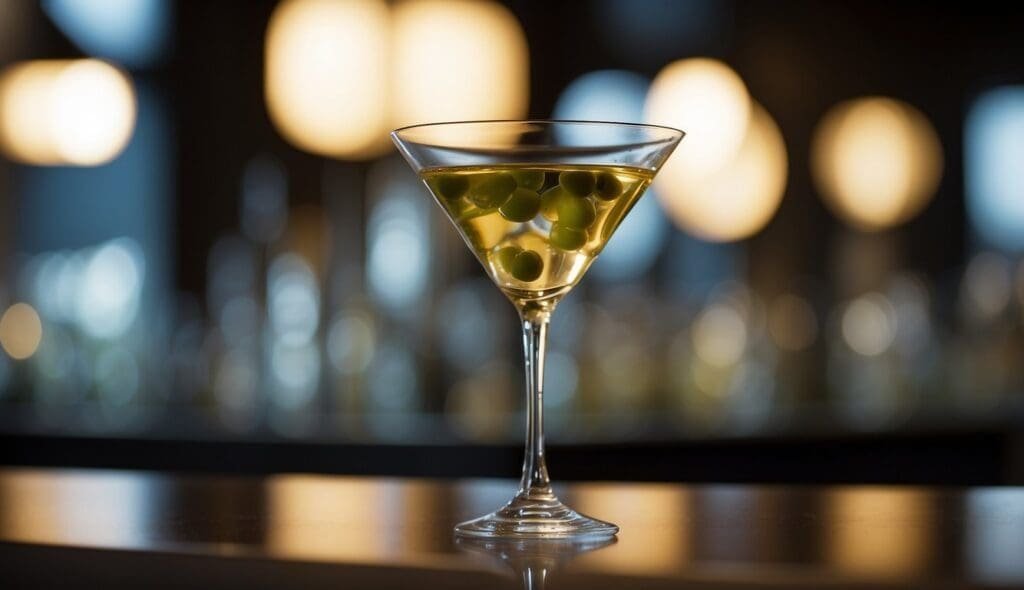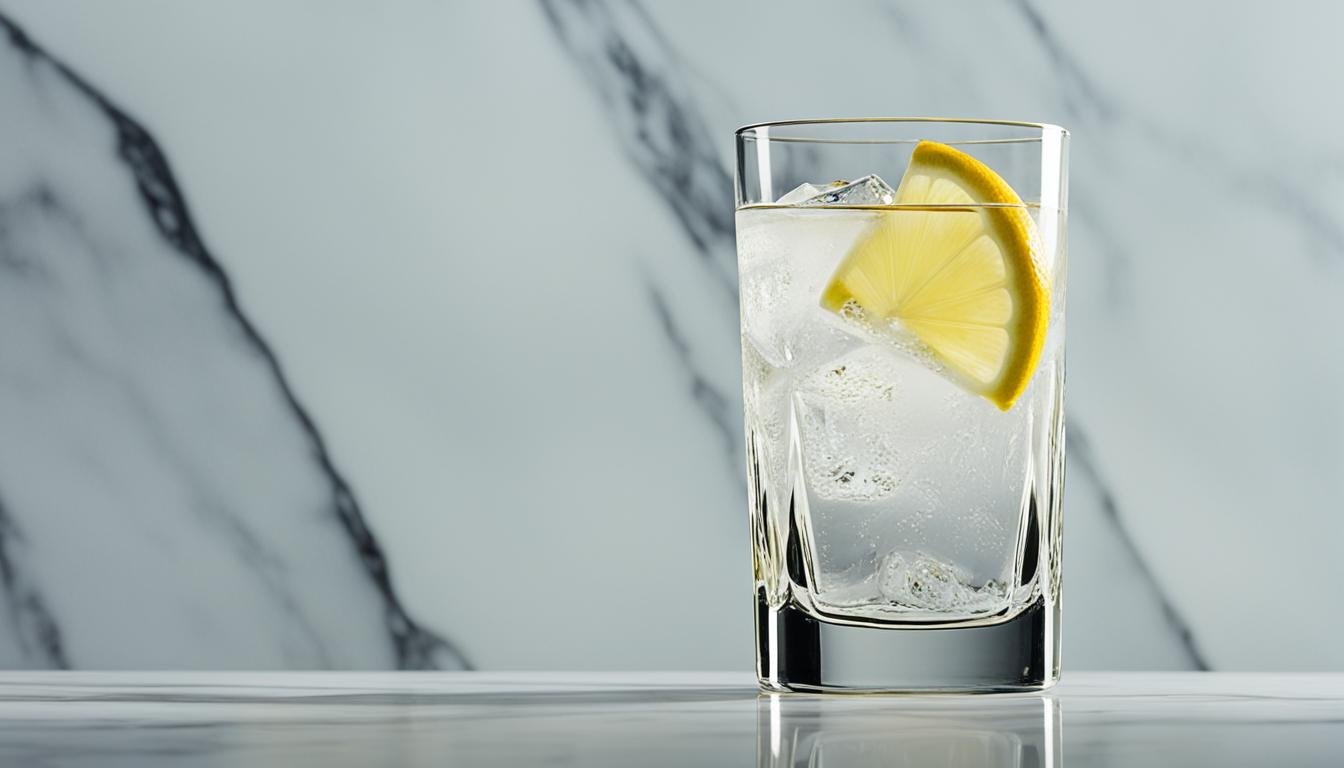Ever thought about why dry vermouth is so key in famous cocktails? We’ll look into what is Dry Vermouth and what this unique wine brings to the table.
Dry vermouth is from Turin, Italy, and people have been enjoying it since the 1780s. Its name, ‘vermouth'(wermut, pronounced “VER-moot”), actually means wormwood in German. This was a key plant used in its early recipes for health reasons.
So, what’s Dry Vermouth made from? It starts with wine or grape must, then adds brandy and special plants for flavour. It has strict rules, requiring it to be at least 75% wine and 14.5-22% alcohol.
It’s known for making cocktails taste better. Whether by itself or in mixed drinks, dry vermouth is a hit around the world. It’s a top choice for those who like to appreciate what they drink.
History of Dry Vermouth
Dry white vermouth has a fascinating history. France was its birthplace, creating it with tantalising herbal and floral scents and a hint of citrus, all low in sugar. It was first used in ancient times for health benefits. But it quickly became a favourite in the 19th century among the upper class. The shift from medicine to must-have in cocktails shows its lasting charm.
Origins in France
France leads in dry white vermouth’s story. Their version, known as white vermouth, pleased with a perfect mix of herbs and spices. Before becoming a refined tipple, it served as a healing tonic. Learning about dry white vermouth sheds light on its evolution from a simple drink to a refined choice.
Spread Across Europe
Dry vermouth’s fame grew, moving through Europe. It was a hit with the upper class. This marked a change where it was seen as being elegant, rather than just for health. Its shift from medicine to mixology shows its endless appeal and usefulness.
Modern Popularity
Today, cocktails are back in style, making dry vermouth important again. Drinks like martinis are loved for their taste and balance, all thanks to dry vermouth. Whether in a cocktail or by itself, dry vermouth’s history and uses can make you value it more.

What is Dry Vermouth?
Dry vermouth is a special type of wine that’s fortified with brandy for more kick. It doesn’t go through distillation, which makes it unique. It’s made by soaking a wine base with herbs and spices. This process gives dry vermouth its special scent and taste.

Definition and Composition
Dry vermouth starts as white wine that’s been given a little brandy. This step increases its alcohol amount. By adding wormwood, mugwort, or cinchona bark, it gets its subtle bitter taste. The mix of brandy and herbs makes it perfect for various drinks.
Botanicals Used
Many different aromatic plants and spices are used to make dry vermouth. Coriander, chamomile, cinnamon, and ginger are a few. They add many layers of taste and smell. These extra ingredients make dry vermouth great straight or in cocktails.
Alcohol Content and Legal Standards
Dry vermouth usually has an alcohol level between 14.5% to 22% ABV. European rules say it must be made mainly from wine. This law keeps its quality high. Dry vermouth has become a key player in cocktails due to these strict rules.
Types of Dry Vermouth
Exploring dry vermouth shows you different styles for various tastes and cocktail needs. Knowing these types can help you choose better, whether you mix drinks a lot or love making them at home.
Extra-Dry Vermouth
Extra-dry vermouth is known for being low in sugar and having a clean taste. It’s great in classic cocktails like the Martini, adding a sharp finish. Looking for a dry vermouth alternative? Extra-dry vermouth might be just what you need. It blends well thanks to its gentle taste.
Pale Yellow Dry Vermouth
Yellow dry vermouth has a bit more sweetness but is still light on sugar. It adds a unique floral taste to drinks. This makes it perfect for cocktails that need a soft but noticeable vermouth flavor. It stands out for its special blend of botanicals.
Dry Vermouth in Cocktails
Dry vermouth is key in many famous cocktails. It is loved for its taste and how it can be used. Learning what is dry vermouth and how to mix it can really up your cocktail skills.
Classic Martinis
Martini’s elegance comes from dry vermouth and gin or vodka. The mix captures the heart of many. It brings a subtle complexity to those who enjoy rich flavours.
The Negroni and Other Cocktails
The Negroni is a prime example of dry vermouth’s value. Mixed with Campari and sweet vermouth, it creates a beloved taste. Dry vermouth also shines in many other cocktails, letting you control alcohol and add aroma.
Using Dry Vermouth in Cooking
Dry vermouth is not just for cocktails. It shines in cooking too, adding rich flavours. It’s a perfect replacement for white wine, adding depth to your meals.
Imagine upgrading a French onion soup. Add dry vermouth for a new layer of taste. Or, use it to braise meats, making them even more delicious and sophisticated.
Dry vermouth is a must-have for any kitchen, not just bars. Next time you cook, think about using it. Its unique qualities can truly elevate your favourite dishes.
FAQ
What is dry vermouth?
Dry vermouth is a fortified wine. It’s made with herbs, spices, and sometimes wormwood. This drink has little sugar. People use it in beverages and cocktails.
How do you drink dry vermouth?
Dry vermouth can be enjoyed in many ways. You can drink it neat, over ice, or mix it into cocktails. It’s known for its herbal taste and adds a refreshing aroma to drinks.
What is in dry vermouth?
Dry vermouth has a wine base and is strengthened with brandy. It features coriander, chamomile, and other herbs. It also contains a bittering agent like wormwood.
What are the uses of dry vermouth?
In cocktails, dry vermouth makes them more interesting. It’s great in drinks like martinis. You can also use it in cooking to boost the flavour of your dishes.
What is the difference between dry and sweet vermouth?
Dry vermouth has a light herbal taste and low sugar. It suits drinks like martinis. Sweet vermouth is richer, with more sugar, and is used in drinks like Manhattans.
Can dry vermouth be substituted in recipes?
Yes, dry vermouth can replace white wine in cooking. It has the same acidity and adds complexity. However, it may change the flavour slightly due to its unique herbs.
What are the origins of dry vermouth?
The story of dry vermouth begins in Turin, Italy, in the 1780s. It first gained fame in France. Soon, it was loved by people across Europe, especially those of high status.
How has dry vermouth spread across Europe?
Originally seen as medicine, dry vermouth was later enjoyed by aristocrats. By the 19th century, it was a hit in cocktails and is now popular worldwide.
What is the modern popularity of dry vermouth?
Recently, dry vermouth has become popular again with cocktail lovers. It’s a key ingredient in many classic drinks and dishes. This has made it a staple in bars and kitchens globally.
What are the botanicals used in dry vermouth?
Dry vermouth uses coriander, chamomile, cinnamon, and ginger. It also contains a bitter herb like wormwood. These ingredients give it a special smell and taste.
What is the alcohol content of dry vermouth?
In Europe, laws say dry vermouth must be 75% wine. It can have 14.5% to 22% alcohol by volume.
What is Extra-Dry Vermouth?
Extra-dry vermouth has very little sugar and a unique smell from its herbs. It’s popular in classic cocktails like the Martini.
What is Pale Yellow Dry Vermouth?
This vermouth is a bit sweeter with a fuller taste than extra-dry. It’s used in cocktails that need a more nuanced flavour.
How is dry vermouth used in classic martinis?
Dry vermouth mixes with gin or vodka in martinis. It creates a cocktail that’s elegant and full of flavour.
How is dry vermouth used in the Negroni and other cocktails?
In the Negroni, dry vermouth evens out the sweet and bitter. Other cocktails also use it as a key part of their taste.
Can you use dry vermouth in cooking?
Absolutely! Dry vermouth brings a rich aroma to dishes. It’s perfect in soups, sauces, and with meats, adding layers of flavour.
User Review
( votes)Sip smarter, subscribe now!
Subscribe for gourmet tips, event updates, travel ideas, and a free e-book on Food Pairings. Start your journey to culinary and travel excellence!













